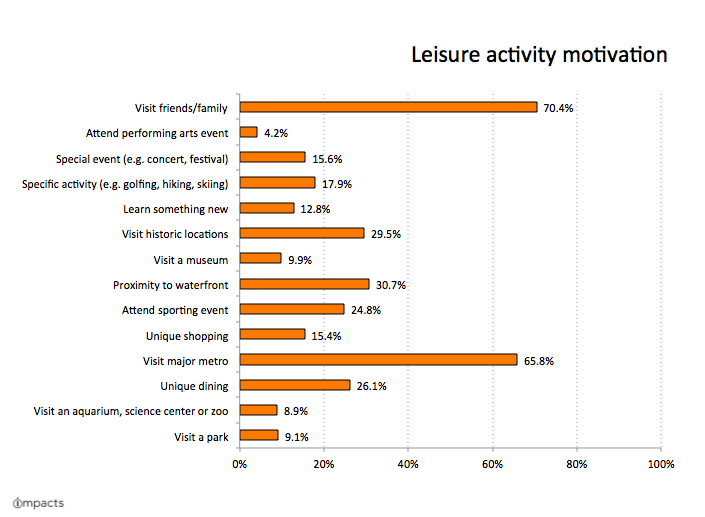When it comes to motivating attendance, data suggest that offerings outside of your visitor-serving organization’s walls often play a greater role than what is inside.
Interested in this information? Here’s a 2017 update to this data and a deeper dive.
Wondering why you’re not getting more people through the door of your museum or performing arts event? It could be due to many factors – both internal and external. Often, visitor-serving organizations (VSOs) get wrapped up in their own content and confuse the role that these offerings play in motivating visitation. Namely, they think that their own content or visitor experience plays the primary motivational role. However, data indicate that an organization’s own internal offerings generally matter less to visitors than does the market’s perceptions of the surrounding macro-environment when it comes to motivating leisure visitation.
The chart below (featuring data collected by IMPACTS) illustrates findings related to leisure activity motivation. In other words, it demonstrates the primary motivators that determine how the market decides what to do with its leisure time. (The x-axis demonstrates the percent of respondents identifying that aspect/activity as a primary motivator. Respondents with multiple primary motivators are also represented.)
This data features several key takeaways for visitor-serving organizations:
1) “Critical mass” plays an important role in motivating leisure activity
“Yeah, yeah – VSOs in bigger cities have more people around and thus usually get more people to come through the door,” you’re probably thinking…but there’s more at play here than one might initially think. Major metro markets contain a density of attributes and experiences such as the ones indicated on this list. However, data suggest that in terms of motivating leisure activities, some markets have stronger, “standalone” motivators than others and merely being a major metro market can be a less enticing draw than possessing a mix of other attributes. A certain way to ensure that your organization is being considered as a viable destination is to be surrounded by a core, critical mass of other leisure opportunities. Consider the Monterey Bay Aquarium (to mention a frequent example for me): Monterey itself is not a major metro market, but the aquarium’s proximity to the waterfront, unique dining, golfing, and other specific opportunities create a density of experience that makes the location a viable leisure destination. In other words, the combination of these attributes – coupled with the appeal of the aquarium – are enough to motivate people to travel 2.5 hours from a major metro market (San Francisco) to visit the aquarium.
2) More than ninety percent of people need external motivators in order to attend your museum or performing arts event
Visitor-serving organizations may overestimate the motivational qualities or singularity of their own offerings in driving activity motivation. The modest influence that visiting a museum (9.9%), a zoo, aquarium, or science center (8.9%), or a performing arts event (4.2%) has on the leisure decision-making process is relatively low when compared to the influence of other visitor experiences or destination attributes. This means that more than 90% of people need additional, external motivators to enter your marketplace. A museum could put a visit to a destination over the top, but it’s generally not a primary motivator. This makes sense when contemplating the opportunity trade-offs attendant to leisure decisions: Visiting Aunt Janet sounds great – but if you could visit a major metro with unique shopping near the water and visit a museum, you might make a different decision (and maybe even bring Aunt Janet)!
3) Who people are with still often beats what they are doing
The highest primary motivator of leisure activity is visiting friends or family (70.4%). This mirrors other data supporting the finding that who visitors are with often means more than what visitors see when they go to a museum or other type of visitor-serving organization. This is worth extra attention, as the greatest motivator according to the market is not tied specifically to a physical aspect or feature of a destination, but rather the draw of being with loved ones.
4) What is good for your city in terms of increasing critical mass is also good for your organization
This is the essence of the “rising tide lifts all ships” theory of visitor engagement. Organizations that see other activities or experiences as competition for their potential audience’s time may be missing the mark. It may go without saying, but communicating the availability of unique shopping and dining, celebrating historic assets within your community, and highlighting hiking, swimming, golfing, or other activities that take place outside your walls also helps you better engage your own visitors.
Occasionally, museums and other visitor-serving organizations want to “silo” their organization as a more influential, standalone experience – a perspective that may be incongruent with the way that the market contemplates its leisure investments. Organizations should be careful to not forget that before a visitor can engage with your content they must first choose to visit your destination. Your visitors’ experience is often connected to the other experiences around you that make up their day. Promoting the robustness and vitality of neighboring organizations and the macro community is increasingly a wise strategy to maximize visitor engagement.
IMPACTS Experience provides data and expert analysis to many of the world’s leading organizations through its workshops, keynote presentations, webinars, and data services such as pricing studies, market potential analyses, concept testing, and Awareness, Attitude, and Usage studies. Learn more.
We publish new national data and analysis every other Wednesday. Don’t want to miss an update? Subscribe here to get the most recent data and analysis in your inbox.



